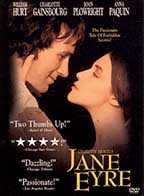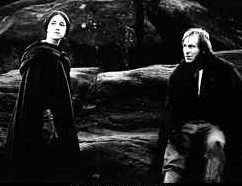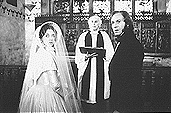An Unearthly Creature
A bleak and shadowy version of Charlotte Brontë's classic Gothic romance directed by Franco Zefirelli, "Jane Eyre" is pleasing enough to the casual viewer (as long as you aren't in a hurry), but it lacks a certain something. William Hurt as Rochester plays opposite Charlotte Gainsbourg in this remake of a classic film of a classic novel.
 I was in the mood for a good romance. I had seen the 1996 Zeffirelli version of the movie relatively recently. Wrapped up in my blanket, warm drink in hand, I was looking forward to a wonderful midnight viewing of a favourite 19th century novel brought to life on the silver screen on Saturday Night at the Movies on TVO.
I was in the mood for a good romance. I had seen the 1996 Zeffirelli version of the movie relatively recently. Wrapped up in my blanket, warm drink in hand, I was looking forward to a wonderful midnight viewing of a favourite 19th century novel brought to life on the silver screen on Saturday Night at the Movies on TVO.
Somehow, I don’t remember it being so dark and dreary during my previous viewing of the film. Somebody must have thought it was a great idea to use the lighting that would have been present in the original period. Period dress is one thing, but “period lighting”? No one could see a thing running around with candles in that dark and dank old mansion. I kept wanting to go over and adjust the T.V. set so that I could see something.
While it might be true that the original author, Charlotte Brontë, successfully created a dark and forboding atmosphere in her novel, I don’t think that the darkness translates very well into a visual medium where you can’t see much half of the time because the set is too dark. It was more of an annoyance than anything else.
 I can’t say that I remember the story line well enough to spot all of the deviations in the film from the original novel. It’s been a while. I certainly remember the large strokes of the plot and the emotional tone of the book, but I am a little fuzzy on some of the details. One thing that I do remember, or at least I think I remember from the novel, is that Mr. Edward Rochester is definitely of a darker appearance than Mr.William Hurt. There is only so far that you can go with William Hurt’s definitively blond look. What the physical appearance leaves wanting has to be filled in by the acting in terms of depicting the dark and stormy Rochester character.
I can’t say that I remember the story line well enough to spot all of the deviations in the film from the original novel. It’s been a while. I certainly remember the large strokes of the plot and the emotional tone of the book, but I am a little fuzzy on some of the details. One thing that I do remember, or at least I think I remember from the novel, is that Mr. Edward Rochester is definitely of a darker appearance than Mr.William Hurt. There is only so far that you can go with William Hurt’s definitively blond look. What the physical appearance leaves wanting has to be filled in by the acting in terms of depicting the dark and stormy Rochester character.
 If William Hurt is not exactly what I had always pictured in terms of a Mr. Rochester, the opposite is true when it comes to Charlotte Gainsbourg as Jane Eyre. Gainsbourg’s physical presence is to me the perfect embodiment of the plain Jane. Gainsbourg has quite the work cut out for her as an actress. The dialogue allowed to her character in the film does not fill in the complexity of emotion and intellectual foment under the surface of her character that comes through in the novel. Jane is habitually a woman of few words. Gainsbourg has to meet the challenge of presenting Jane’s character through means other than the dialogue supplied.
If William Hurt is not exactly what I had always pictured in terms of a Mr. Rochester, the opposite is true when it comes to Charlotte Gainsbourg as Jane Eyre. Gainsbourg’s physical presence is to me the perfect embodiment of the plain Jane. Gainsbourg has quite the work cut out for her as an actress. The dialogue allowed to her character in the film does not fill in the complexity of emotion and intellectual foment under the surface of her character that comes through in the novel. Jane is habitually a woman of few words. Gainsbourg has to meet the challenge of presenting Jane’s character through means other than the dialogue supplied.
One of the things that moved me the most in this film was the depiction of the childhood friendship of Jane with Helen Burns. Helen dies of consumption part way through the film in the midst of the grim conditions of the Lowood boarding school. A piercingly touching exchange takes place between the two young friends the night that Helen dies of consumption. In the darkness, Helen says, “Don’t cry, Jane. You mustn’t cry. We’ll be together again. . . We’ll be together again in heaven forever and always.” Jane expresses doubt. Helen replies, “Don’t you believe it, Jane? You must believe it.You must believe! God will take care of us. Good night, dearest Jane.”
 For one reason or another, the scene struck close to home. Perhaps it was the recent memory of the biographical television series about the talented Brontë family seen on TVO. Charlotte Bronte watched her mother and all of her sisters die tragically young of consumption before she herself was taken at an early age. Perhaps it is anticipation of a similar conversation with a friend of mine who is facing the possibility of an untimely death. My friend presently has no hope of a better afterlife and no assurance of a caring Father watching over her. Perhaps it was my little daughter’s midnight coughing fits from yet another upper respiratory tract infection breaking through the silent night as I watched the film. My little girl has told me recently of both her fears about death (being put into a dark pit) and about her childlike trust in God’s provision of heaven.
For one reason or another, the scene struck close to home. Perhaps it was the recent memory of the biographical television series about the talented Brontë family seen on TVO. Charlotte Bronte watched her mother and all of her sisters die tragically young of consumption before she herself was taken at an early age. Perhaps it is anticipation of a similar conversation with a friend of mine who is facing the possibility of an untimely death. My friend presently has no hope of a better afterlife and no assurance of a caring Father watching over her. Perhaps it was my little daughter’s midnight coughing fits from yet another upper respiratory tract infection breaking through the silent night as I watched the film. My little girl has told me recently of both her fears about death (being put into a dark pit) and about her childlike trust in God’s provision of heaven.
In the film, the emotionally abusive Mr. Bocklehurst is seen as a stiff and puritanical authority figure with a twisted sense of Christian duty in regards to caring for his young charges. He stands in stark contrast to the sympathetic Miss Temple, who becomes a mentor and a model for Jane. One wonders how we are ever supposed to believe that Jane Eyre could ever turn out to be a halfway stable and well-rounded individual given the years of rejection and abuse that she suffers. The presence of Miss Temple at Lowood gives a clue as to how, at least in the author’s mind, Jane could survive the deprivations and still be intact: Miss Temple, upon the moment of Jane’s departure from Lowood, says, “I believe that it is God’s will I am here. I cannot leave.” Grace intervenes in the darkest places and redeems an otherwise hopeless situation.
Miss Temple articulates what appears to be a mantra of Charlotte Brontë’s own personal experiences as a female author in the early part of the 19th century. About the girls at Lowood School, Miss Temple maintains, “But you have all been blessed with intelligence. Intelligence and a proper education will give you independence of spirit. And that is the greatest blessing of all. The only thing that matters in your life is to be in harmony with God.”
 The theme of grace and redemption continues in the main plot as the action moves forward to Thornfield Hall. Rochester asks a basic question about his own potential for redemption. As he is about to ride off to his next diversion from his painful home life, Rochester throws down a challenge before Jane: “Fortune has knocked me about. I once had a heart full of tender feelings. Now I’m as hard and tough as an Indian rubber ball. Think there is any hope for me?”
The theme of grace and redemption continues in the main plot as the action moves forward to Thornfield Hall. Rochester asks a basic question about his own potential for redemption. As he is about to ride off to his next diversion from his painful home life, Rochester throws down a challenge before Jane: “Fortune has knocked me about. I once had a heart full of tender feelings. Now I’m as hard and tough as an Indian rubber ball. Think there is any hope for me?”
One character who appears to be beyond the reach of redemption in the film is Jane’s aunt, Mrs. Reed. On her deathbed, Mrs. Reed remains a soul tortured by her unfair and unreasonably harsh treatment of Jane. The aunt rejects Jane’s offer of forgiveness and reconciliation. Jane’s fortunes eventually change. The aunt steps off the planet into eternity in a state of guilt and alienation. The attempt to make amends has somehow not had a totally beneficial effect. Redemption does not come to everyone.
 Through a maze of complications, Rochester and Jane end up saving each other from a less than ideal situation. Jane, recently elevated in social status, reaches down, and Rochester, mangled by the fickle winds of fortune, reaches up. They meet in the middle and all is right in the world in the end.
Through a maze of complications, Rochester and Jane end up saving each other from a less than ideal situation. Jane, recently elevated in social status, reaches down, and Rochester, mangled by the fickle winds of fortune, reaches up. They meet in the middle and all is right in the world in the end.
It’s an old fashioned romance, with old fashioned heroes and heroines. I love it. It’s a story that couldn’t exist in the modern world. Come to think of it, it didn’t really exist in the world of way back when either, but why not at least entertain the thought? I can think of a lot worse ways to spend a bleak November night.
Further Reading:
- Read the original Brontë novel online.
- "In Search of the Brontës", a TV series shown on TVO reflects the personal story of Charlotte Brontë, also found online in a mini-biography
- .Finding love after growing up in an abusive home.
- Redeeming stories in the movies.
- Miss Temple: "The only thing that matters in your life is to be in harmony with God."